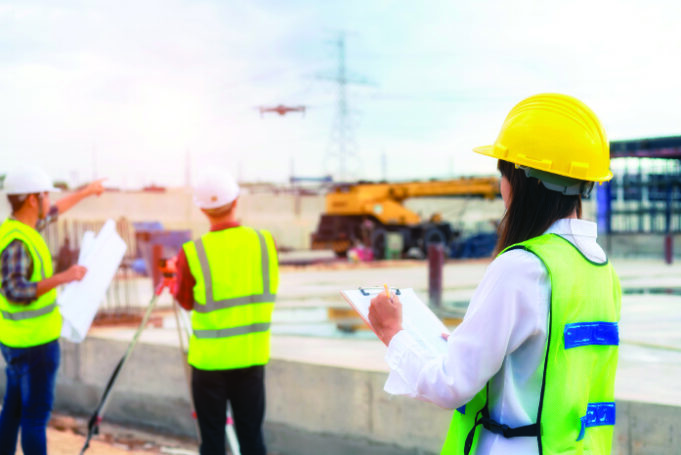By Donna Campbell
Due to the advances in technology designed for the construction industry, there are more innovative solutions to choose from for estimating and bidding, project readiness, and safety measures. I had the opportunity to speak with Casey Banks, senior regional risk control consultant at Travelers, about his thoughts regarding technology’s impact on today’s construction jobsites. Here’s an excerpt of our exchange via Q&A.
MCS: How are you seeing technological innovations reshape the construction industry?
BANKS: Innovative technologies continue to play an important role in enabling safer, more efficient jobsites. We’ve seen many of our customers benefit from incorporating a variety of solutions designed to address some of the main pain points they’re facing—such as the lack of skilled labor, real-time project visibility, and the rising costs of worker injuries.
For instance, smarter, more connected jobsites that provide instant data on worker locations can reduce response times to anyone who gets injured. The improved visibility has been proven especially critical during the COVID-19 pandemic, allowing companies to respond rapidly in the event of a positive case. Another benefit is that these tools can aid in maintaining control over who is or is not allowed on the jobsite.
With all the new types of technology, many contractors are trying to figure out the best approach to leveraging advanced systems to help them improve safety, while staying competitive in a world where projects are becoming “smarter” and more connected across the industry.
MCS: How can new technologies–such as drones for site surveillance or smart wearables for physical safety–be used to improve safety on the jobsite?
BANKS: Each technology brings with it the potential to address a specific challenge. Take drones, for example. Historically, workers would climb up on a roof or other elevated platform to inspect a building or a piece of equipment. Today, we are seeing more contractors realizing the benefits of using drones to get that bird’s-eye view without risking potential falls.
You also mentioned smart wearables. While they can differ, many are designed to help prevent worker accidents and injuries. For instance, a worker wearing a proximity sensor could receive an audible or vibratory alert to notify them when they’re too close to a piece of heavy equipment or entering unauthorized or hazardous areas.
Another example would be having workers with less experience take simulation-based training through mixed-reality platforms. This type of solution allows workers to experience real-life situations without physically being in harm’s way. This can be especially useful in training workers to use equipment, including cranes, and on how to protect themselves against falls.
MCS: Why is it important that construction businesses constantly evolve their protective measures to minimize risks to employees and their business, especially around new technology?
BANKS: We’ve seen the industry continue to evolve, especially over the last few years, with increased use of technology on jobsites. You may recall that, not too long ago, there was resistance to devices such as cameras and tablets. Once contractors and workers realized usage benefits, including how easy they were to use and how they could help with safety, production, and quality control, acceptance grew.
Even with all the technological advances, maintaining a sharp focus on worker safety will always be critical, as physical labor remains vital to every project. This reality requires understanding the risk landscape on each project and knowing which prevention and mitigation tactics to put in place to reduce the potential for accidents and injuries.
MCS: How is Travelers helping construction businesses foster safe working environments and the safe use of technology?
BANKS: As one of the largest providers of insurance in the construction industry and a leader in the workers compensation space, we understand how things can go wrong on construction sites. One of the reasons we work so closely with our customers is to help them find ways to improve worker safety and avoid workplace injuries.
Our dedicated underwriters, Claims professionals, and Risk Control consultants work with contractors to share industry insights, assist in analyzing risk, manage claims to improve outcomes, and provide information on safety, health, and risk management programs to prevent loss.
We’re testing and piloting many emerging-technology solutions, such as proximity sensors and wearable devices for worker safety, as well as water sensors designed to help identify potential risks associated with water damage. These efforts allow us to better understand their uses, risks, and benefits so that we can pass those observations on to our customers and help them make more informed decisions.
We also work with customers to help them understand how they can use all the data from these solutions to improve jobsite safety. For instance, this information can empower managers to provide feedback to workers to help prevent unsafe behaviors and as part of longer-term planning and strategy development.
CLOSING THOUGHT
Regardless of the technology that’s being used, establishing an effective safety culture that starts with top management will remain a critical component of preventing loss. It is important for managers to lead by example and to hold workers accountable to established safety programs.
For more information:
Casey Banks is a senior regional risk control consultant at Travelers. For more, visit www.travelers.com/business-insurance/construction.
Modern Contractor Solutions, July 2021
Did you enjoy this article?
Subscribe to the FREE Digital Edition of Modern Contractor Solutions magazine.



